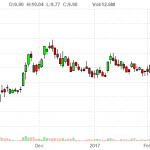Global financial markets ended the week on a positive note with a boost from Asian share markets. Asian share markets rose to their best levels in more than two years as positive data on US manufacturing and employment and buoyant European factory growth boosted investor optimism. The Japanese Nikkei 225 ended the week up by 2.5% while Hong Kong’s Hang Seng was up by 1.1%. Except German indices, European share markets ended the week on a flattish note. The German Dax ended the week up by 1.8% and closed at an all-time high on the back of strong German manufacturing data. France’s CAC 40 ended the week up 0.1% and London’s FTSE 100 was flat.
US markets ended the week marginally higher by 0.6% despite sluggish job growth data. The data showed U.S. economy created fewer jobs than expected last month market. The unemployment rate fell from 4.4% to 4.3% during the month however, it is viewed as a negative since the number of people participating in the workforce also declined.
Despite the disappointing data, market participants still largely anticipate the Federal Reserve to raise rates at its June 13-14 meeting, with traders expecting a 90.7% chance of a quarter-point hike, according to Thomson Reuters data.
But you know our view. We doubt the Fed’s ability to raise interest and reach the long-term ‘normal’ of 3%.
Key World Markets During the Week

Back home, Indian stock markets continued their positive momentum and closed at record highs at the end of the week. Expectations of a good monsoon and the impending GST implementation kept the indices buoyant. FMCG stocks rallied during the week as they expect to benefit the most from GST implementation. Pharma stocks too staged a recovery after they took a beating last week. The BSE Healthcare index closed the week up by 2.1%. The Indian stock market ended the week higher by 0.8%.
BSE Indices During the Week

Now let us discuss some key economic and industry developments during the week gone by.
In news from economic sector, as per a leading financial daily, with an aim to achieve India’s overall growth rate to 8%, Niti Aayog Member V K Saraswat has said that manufacturing sector in country needs to grow at almost 12-14% compound annual growth rate (CAGR). He also said that the country intended to achieve a 25% contribution by the manufacturing sector to its GDP by 2022.
Saraswat expects that the GDP to grow to almost US$2.7 trillion to US$3 trillion by 2022, so the manufacturing contribution to the GDP will be almost 25%. Therefore, he said that they are aiming at US$670 billion, almost adding around 100 million jobs in that direction. He also highlighted that the manufacturing sector’s contribution to the GDP was 15% in the fiscal year 2015, almost US$270 billion in a GDP of US$1.8 trillion.
Citing the cutting-edge developments in defense sector worldwide, Niti Aayog Member has said that India could not omit the defense and aerospace sectors if it intended to inject a higher level of input from the manufacturing sector to its economy. He noted that the country’s current share of GDP expenditure for research in the defense sector was insufficient.
He also said that they are still spending 0.9% of the GDP in research and development (R&D) and if compare to the top five (defense spenders in world), they are way down. Therefore, he said that the country needed to pump in more investments in research and development to compete with global giants in defense.
As per the data released by Central Statistics Office (CSO), Gross Domestic Product (GDP) in the January-March quarter grew at the slowest pace in at least four quarters at 6.1% as against a 7% growth in October-December.
The GDP growth, with revised series, was dragged down by construction, manufacturing and trade services thereby stripping the country of its status as the world’s fastest-growing major economy. Annual economic growth at 6.1% was lower than China’s growth of 6.9% for the first three months of 2017.
The expansion was much slower than the 6.5-7.8% forecast by analysts, and below the provisional 7% growth reported in the previous quarter.
Surely, the lower-than-anticipated fourth quarter GDP number reflects the lingering impact of demonetization, as predicted by economists. They believe that the sharp expansion in government consumption expenditure in January-March has in fact bolstered GDP growth from an even sharper slowdown.
The global credit rating agency, Moody’s Investors Service in its latest report ‘Global Macro Outlook’ has said that Indian economy will grow by 7.5% in the current fiscal year, 7.7% in 2018-19 and will reach to around 8% in 3-4 years on the back of government’s various reforms.
Whereas the World Bank in its ‘India Development Report’ has increased its hopes that India will grow at 7.2% in the current fiscal and further up to 7.7% by 2019-20 on strong fundamentals, reform momentum and improving investment scenario. The World Bank had in January scaled down India’s growth forecast to 7% for 2016-17 and had estimated growth to rebound in 2017-18 to 7.6%.












Leave A Comment